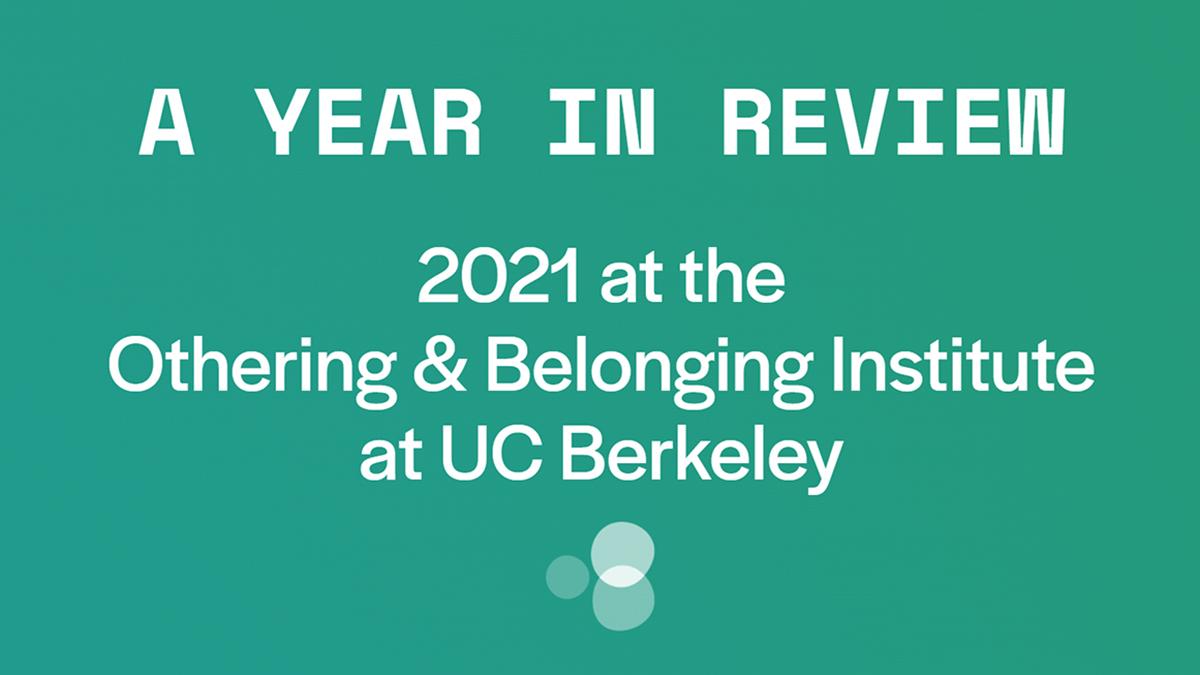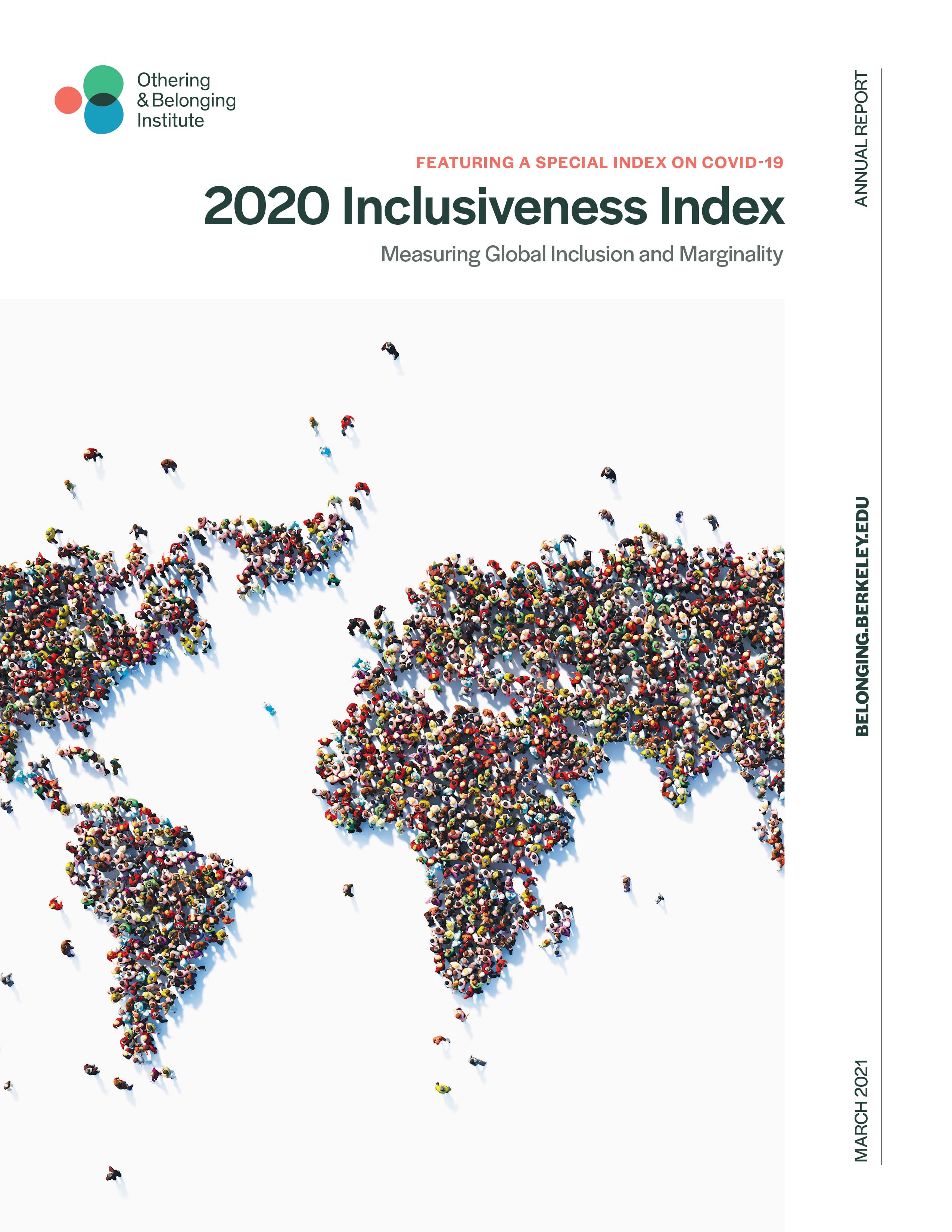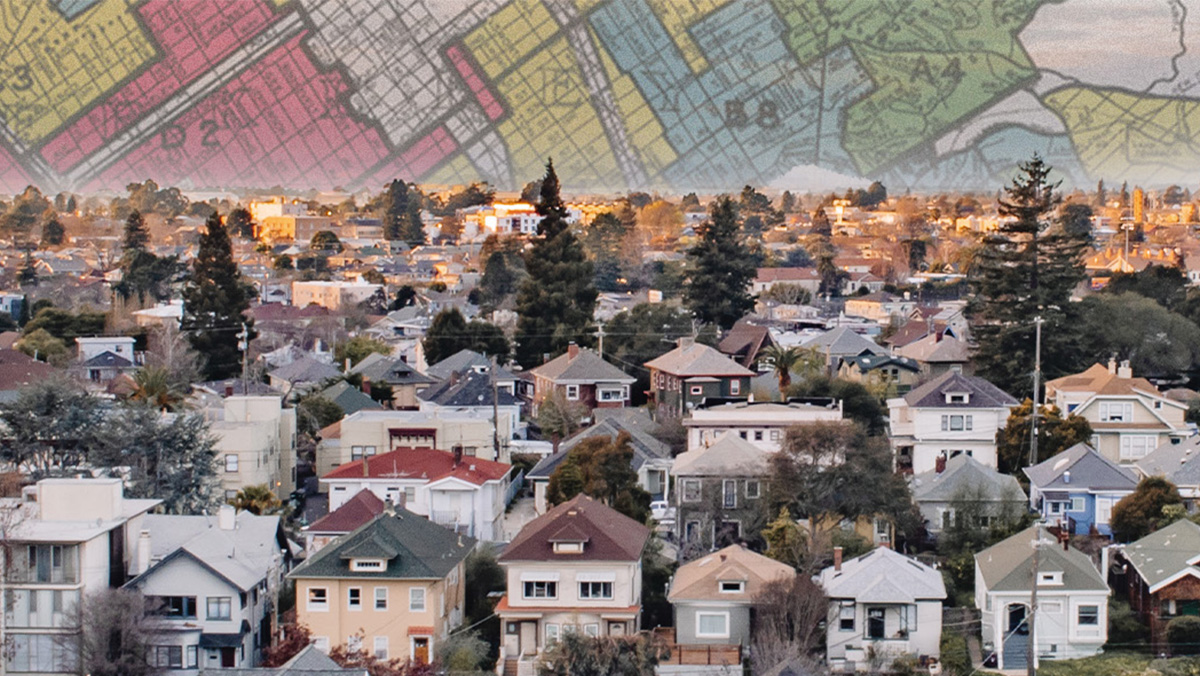OBI in the Media
When the press and public highlight our work, it tells us that our research resonates with a wide audience and has the potential to impact the landscape outside the institute. Making waves in the media means that we're able to shape conversations around policy, society, and daily practice in crucial ways.
Below are just a few of the pieces that made headlines across the country and world, and a small sample of our media growth in 2021.
2020 Inclusiveness Index
For five years, the authors of the Inclusiveness Index have identified and captured the degree of group-based inclusion and marginality experienced across the world and within the United States. In the 2020 edition, the report responded to an unprecedented pandemic by building an index to rate state and country policy responses to the COVID-19 pandemic. This index ranked country performance along three key factors, including 1) number of infections, 2) COVID-19 deaths, and 3) COVID-19 testing — all measures of the efficacy of public health measures.
Published just over a year into the pandemic, newsrooms picked up the report widely — both for its coverage of global inclusiveness, and its incisive coverage of COVID responses.
- Colorado's COVID-19 Response Ranks 17th In Nation: UC Berkeley (Patch) | March 31, 2021
- Arizona's COVID-19 Response Ranks 47th In Nation: UC Berkeley (Patch) | March 31, 2021
- Minnesota's Coronavirus Response Ranks Among Best In U.S.: Index (Patch) | April 1, 2021
- Patch: Washington's Coronavirus Response Ranks Among Best In U.S. (Patch) | April 1, 2021
- As vaccinations plateau, Alaska sees a spike in Covid cases (Fairbanks Daily News-Miner) | April 1, 2021
- NC's Coronavirus Response Ranks Among Best In US: Index (Patch) | April 1, 2021
- U.S. Coronavirus Response Ranks Among Global Worst: Index (Patch) | April 1, 2021
- Michigan's COVID-19 Response Ranks 26th In Nation: Report (Patch) | April 1, 2021
- Arizona ranks No. 47 out of 50 states for COVID response (AZ Big Media) | April 3, 2021
- Virginia's Coronavirus Response Ranks Just Outside Top 10: Index (Patch) | April 5, 2021
- NJ Coronavirus Response Ranks Among Worst In America: Index (Patch) | April 5, 2021
- PA Coronavirus Response Ranks Among Worst In U.S.: Study (Patch) | April 5, 2021
- Patch: Maryland's Coronavirus Response Ranks Among Best In US: Index (Patch) | April 6, 2021
- Report Ranks Arizona's COVID-19 Response Among Worst In U.S. (KJZZ) | April 6, 2021
- Maryland Matters Report: Maryland Among Best States for 2020 Pandemic Response, But US Ranked Low Globally (Maryland Matters) | April 7, 2021
- Study ranks states' responses to COVID-19 pandemic (WBAL TV) | April 7, 2021
- UC Berkeley study finds U.S. ranks poorly in global COVID-19 responses (Daily Cal) | April 9, 2021
- Patch: California's Coronavirus Response Ranks Among Best In U.S.: Index (Patch) | April 11, 2021
- Patch: Ohio's Coronavirus Response Ranks Among Best In U.S.: Index (Patch) | April 12, 2021
- Yahoo News: When it comes to COVID-19, what's the matter with Maryland? (Yahoo! News) | April 13, 2021
- Patch: GA Is The Least Safe State During COVID, Report Says: Here's Why (Patch) | April 15, 2021
- Berkeley Study: Hawaiʻi Most Inclusive State In the Country (Hawaii Public Radio) | April 19, 2021
Islamophobia through the Eyes of Muslims
In 2021, we expanded our existing work on Islamophobia to encompass the everyday experiences of Muslims in America. The authors of this report developed and administered a national survey to hear from those who bear the brunt of Islamophobia. The study also sought to account for the diversity of U.S. Muslims and assess their societal engagement, worldviews, and belonging as they navigate their lives.
The report received much attention, twenty years after 9/11 and in the wake of anti-Muslim vitriol from the Trump presidency. In particular, the study was noted for its focus on women's experiences of racism and anti-Muslim sentiment.
- Berkeley survey: Majority of Muslim Americans face Islamophobia, especially women (San Francisco Chronicle) | Sept. 29, 2021
- Muslim women more likely than men to experience Islamophobia, survey finds (Religion News Service) | Sept. 29, 2021
- Over two-thirds of US Muslims experience Islamophobia: Survey (Anadolu) | Sept. 30, 2021
- Over Two-Thirds Of Muslim Americans Have Faced Islamophobia, New Survey Finds (HuffPost) | Oct. 1, 2021
- Majority of US Muslims have experienced Islamophobia, poll finds (Middle East Eye) | Oct. 1, 2021
- More than two-thirds of US Muslims have experienced Islamophobia, poll finds (The New Arab) | Oct. 1, 2021
- Islamophobia is a ‘very big problem’ most likely to affect women (The Muslim Vibe) | Oct. 1, 2021
- NST Leader: United States of Islamophobia (New Straits Times) | Oct. 2, 2021
- UC Berkeley survey finds most Muslim Americans face discrimination (DailyCal) | Oct. 5, 2021
- More Women Are Targets of Xenophobic Hate (Richmond Pulse) | Oct. 13, 2021
- Islamophobia undermines and weakens U.S. Muslim women’s rights (SF Examiner) | Oct. 18, 2021
- Ilhan Omar Urges Creation Of Special Envoy Role To Combat Global Anti-Muslim Hate (HuffPost) | Oct. 21, 2021
- A UC Berkeley study explores Islamophobia 20 years post 9/11 (KALW) | Nov. 18, 2021
The Roots of Structural Racism
This report is among the most ambitious studies of structural racism in the United States — and, in particular, its roots in racial residential segregation — done to date. It consists of narrative on the intensification of racial residential segregation; an interactive mapping tool illustrating segregation (and integration) across the country; lists of cities and metropolitan regions by various measures of segregation and political polarization; and much more. The report was updated later in the year to incorporate recently released 2020 census data.
During a year dubbed by many media outlets and academics as a "year of racial reckoning," the authors of this report offered a much-needed intervention in the conversation: a turn to racial residential segregation as the “lynchpin” that sustains systemic racial inequality.
- The Lasting Legacy Of Redlining (FiveThirtyEight) | Feb. 9, 2022
- Racial residential segregation has gone down in Sacramento, study finds (Sacramento Bee) | Oct. 14, 2021
- Racial segregation is alive and well -- and gripping America's cities (CNN) | Sept. 23, 2021
- Opinion | It’s Time to Dismantle America’s Residential Caste System (Politico) | Sept. 12, 2021
- Berkeley Study: Salinas ranks high on the list of segregated metropolitan regions (KION 5/46) | Aug. 19, 2021
- The Resilience of New York’s Black Homeowners (New York Times) | Aug. 17, 2021
- U.S. neighborhoods are more segregated than a generation ago, perpetuating racial inequity (NBC Think) | Aug. 16, 2021
- SB 9 could help ease racial wealth gap, housing crisis (East Bay Times) | Aug. 15, 2021
- Study on Racial Residential Segregation Finds Surprising Contrasts Between Denver and Colorado Springs (The Colorado Trust) | Aug. 11, 2021
- Do you live in one of Memphis’ Blackest, whitest or most segregated neighborhoods? (MLK 50) | Aug. 6, 2021
- Florida city paints a different racial portrait of America (Christian Science Monitor) | Aug. 3, 2021
- California has a segregation problem (CalMatters) | July 11, 2021
- ‘Sea of white’: Marin segregation detailed in UC study (Marin Independent Journal) | July 10, 2021
- U.S. Residential Segregation Is Likely to Get Worse: New Study (Bloomberg News) | July 8, 2021
- Research Traces Roots of Racial Disparities to Residential Segregation (San Francisco Public Press) | July 8, 2021
- New Report Finds Major US Metro Areas, Greater Los Angeles Among Them, Are More Segregated Now Than 30 Years Ago (AirTalk) | July 8, 2021
- Oakland Ranks High On List Of Segregated Cities, According To UC Berkeley Study (KALW) | July 7, 2021
- Measuring Diversity and Segregation in U.S. Cities (Wall Street Journal) | July 7, 2021
- The Mission isn’t as racially segregated as the Bay. Does that point to gentrification? (Mission Local) | July 7, 2021
- Where segregation has changed in DC — and where it hasn’t (Greater Greater Washington) | July 6, 2021
- LA has more diversity but is still segregated. Could that mean more uprisings? (KCRW) | July 6, 2021
- The Only Thing Integrating America (The Atlantic) | July 2, 2021
- Big Pharma Price Gouging; How Segregation Persists; Drones Go Global (Political Misfits Podcast) | July 1, 2021
- Muslim Network News TV interview | June 30, 2021
- D.C. Mayor Has the Money to Pay Off Pandemic Rent Debt (Bloomberg News) | June 30, 2021
- New study shows racial housing discrimination increased nationwide (UpFront on KPFA) | June 29, 2021
- Shocking new study shows segregation growing worse in surprising parts of US (The Hill) | June 29, 2021
- Most major US cities have become more segregated in recent decades: report (Smart Cities Dive) | June 28, 2021
- The U.S. has become more segregated. That could make gerrymandering worse. (The Fulcrum) | June 28, 2021
- ‘Where you live determines everything’: why segregation is growing in the US (The Guardian) | June 28, 2021
- Your city is more segregated than it was in 1990, new study shows (Grist) | June 28, 2021
- L.A. segregation problems unchanged in decades, study shows (Los Angeles Times) | June 28, 2021
- How segregated is your Oakland neighborhood? (Oaklandside) | June 28, 2021
- What's Making the Bay Area More Segregated? (KCBS Radio) | June 26, 2021
- Researchers Say ‘Chronic Disinvestment’ Has Led to Detroit Being the Most Segregated City In the U.S. (Atlanta Black Star) | June 25, 2021
- Cities Have Grown More Diverse, And More Segregated, Since the 90s (Commercial Observer) | June 25, 2021
- Racial Segregation is Still an Issue in Most Metro Areas (Legal Reader) | June 24, 2021
- How 3 Decades of Increased Segregation in the Bay Area is Hurting Communities of Color (KQED) | June 24, 2021
- U.S. Latinos earn less, die earlier in segregated areas (Axios) | June 24, 2021
- Study: Racial segregation is increasing in the Bay Area and across the US (SF Gate) | June 23, 2021
- Sacramento ranks as a ‘highly segregated’ city, study finds. Why it’s worse than 30 years ago (Sacramento Bee) | June 23, 2021
- Othering & Belonging Institute holds residential segregation seminar (Daily Californian) | June 23, 2021
- Bay Area segregation is worsening, UC Berkeley study finds (San Francisco Chronicle) | June 22, 2021
- Segregation Is Getting Worse in the US. The Bay Area Is No Exception (KQED) | June 22, 2021
- KPIX Television interview with Stephen Menendian | June 22, 2021
- Report: Oakland, Fremont among U.S. metro areas that have become more segregated + Television interview with Stephen Menendian (KTVU Fox 2) | June 22, 2021
- Study: US more segregated now than 1970, including Bay Area (KCBS) | June 22, 2021
- ABC7 News interview with Stephen Menendian (ABC7 News) | June 21, 2021
- Four-Fifths Of U.S. Metro Areas More Segregated In 2019 Than In 1990, While Detroit Is The Most Segregated City In Country (Forbes) | June 21, 2021
- Most major metropolitan areas have become more racially segregated, study shows + Reporter Nicquel Terry Ellis on air (CNN) | June 21, 2021
- Study Finds That Detroit is the Most Segregated City in the Country (The Root) | June 21, 2021
- The U.S. Is Increasingly Diverse, So Why Is Segregation Getting Worse? (Time) | June 21, 2021
- Bay Area is Becoming More Racially, Economically Segregated: UC Berkeley Study (NBC Bay Area) | June 21, 2021
- The D.C. Region Has Become More Diverse — But Also More Segregated, Study Finds (DCist) | June 21, 2021
- Segregation Has Grown Worse in Most Big Metros, Analysis Finds (Route Fifty) | June 21, 2021
- Most big cities have become more racially segregated: study (New York Post) | June 21, 2021
- How American racism is rooted in residential segregation (Berkeley News) | June 21, 2021
- Map: Most and least segregated metro areas in the U.S. (East Bay Times) | June 21, 2021
- Bay Area has become more segregated over decades, report says (East Bay Times) | June 21, 2021
- Detroit ranked as one of the most segregated cities in the country (Michigan Radio) | June 21, 2021
- Most segregated city in America is Detroit. How that impacts Detroiters (Detroit News) | June 21, 2021
- Segregation is getting worse in most large US cities: report (Raw Story) | June 21, 2021
john a. powell on "Last Week Tonight with John Oliver"
As attention turned to racial segregation, OBI also made it onto the television airwaves. "Last Week Tonight," a show hosted by comedian and political commentator John Oliver, produced a major segment on housing segregation and reparations in which OBI director john a. powell was included. The show featured an interview powell did in a 2011 documentary, Hiding in Plain Sight: The Walls That Divide Us.
Watch the whole segment here or click below.






